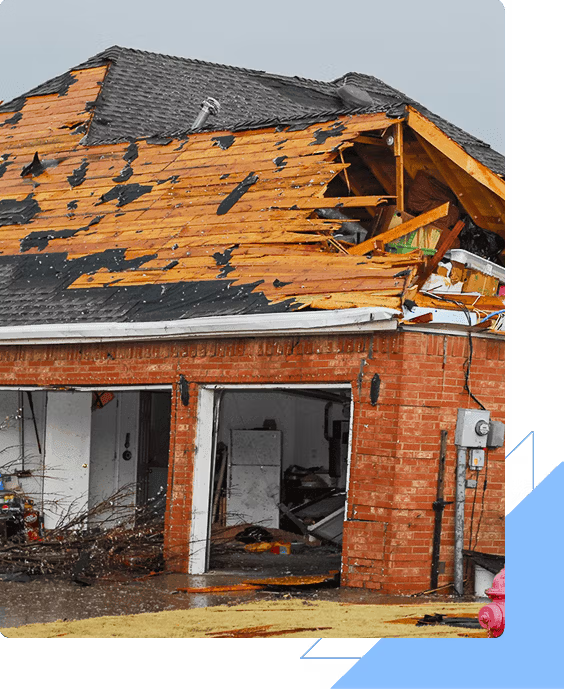You’re lying in bed, listening to the gentle pitter-patter of rain on your roof when suddenly you feel a drip…then another. Your heart sinks as you realize that there’s a leak in your roof. It’s one of those homeowner nightmares that we hope to avoid but sometimes, unfortunately, have to face.
The thought of dealing with insurance claims and repairs can be overwhelming, but don’t fret! We’ve got you covered.
In this step-by-step guide, we will walk you through the process of successfully making a roof leak insurance claim. No jargon or confusing terms – just simple and clear instructions so you can navigate this challenge with ease and confidence.
From identifying and documenting damage to understanding your policy and meeting with the insurance adjuster, we’ll be right beside you every step of the way. And if things get tough? We’ll also show you how to handle denials and appeals effectively.
So take a deep breath – let’s tackle this together!
Identifying the Damage
Before you can even think about making a claim, it’s crucial that you thoroughly identify and document the damage. This isn’t just about spotting where the water’s dripping in, but understanding the true extent of the harm done to your home. It’s like being a detective on your own turf.
Get up close and personal with every nook and cranny of your roof. Look for signs of wear and tear, such as missing shingles or noticeable cracks. Don’t forget to also check out your attic space – often times, hidden leaks show their ugly heads here first.
Take pictures, jot down notes, really immerse yourself in this investigation phase – because it’s not just about defending your claim later on; it’s about knowing what needs fixing to make sure you’re safe under that roof.
Now don’t let it overwhelm you; I know it can seem like a lot to take in. That’s why we’re rolling up our sleeves together here: so you know exactly what needs doing when dealing with roof leak insurance claims.
After documenting everything visually, consider hiring a professional roofer or inspector for an expert opinion if things still look murky or daunting to you. Remember darling, there’s no shame in seeking help when needed – especially when protecting one of your most valuable assets: your home sweet home!
So face this challenge head-on with tenacity and wisdom– because knowing is half the battle won already!
Documenting the Damage

When you’re faced with water seeping through your ceiling, it’s crucial that you quickly grab your phone or camera to snap pictures of the affected areas. This isn’t just for Instagram or an attempt to gain sympathy likes on Facebook; rather, these images serve as tangible proof of the damage caused by the leak. They provide a clear timeline and scope of the incident, which is invaluable when making an insurance claim.
Take multiple shots from different angles, ensuring each photo clearly shows the extent and severity of the damage. Don’t forget to include any damaged personal belongings in your shots.
Now that you’ve captured some pretty damning evidence, don’t stop there. Your photos will tell a powerful story but coupling them with detailed notes can make your case even more compelling. Write down when you first noticed the leak, how fast it seemed to spread, what actions you took to mitigate further damage—these details matter! If possible, also record weather conditions around this time because if heavy rain or hail was involved, it could strengthen your claim.
Remember – thorough documentation is not about turning this into a Sherlock Holmes mystery; rather it helps paint a vivid picture for your insurance company so they understand exactly what happened and why their support is essential in fixing it.
Understanding Your Insurance Policy
You’ve got the damage documented, now it’s time to dive into your insurance policy and understand what’s covered and what’s not. Trust us, this step is just as important as the rest.
Don’t let yourself be blindsided by unfamiliar jargon or seemingly complex clauses. Instead, take a deep breath and carefully examine each page of your policy.
Look for key sections that discuss coverage limitations, exclusions, deductibles, and claim procedures.
We know insurance policies can feel like they’re written in another language sometimes – but don’t worry! You’re not alone in feeling overwhelmed.
If you find yourself scratching your head over something, reach out to your insurance agent right away. They’re there to help clarify any confusing points and guide you through the claims process.
Remember: understanding your policy fully is crucial before moving forward with a claim – you need to know exactly where you stand so there won’t be surprises down the line.
So go on now – get cozy with that policy!
Contacting Your Insurance Company
Now’s the time to dial up your insurance company, no dilly-dallying! Remember, you’re not in this alone. Your insurance company is there to guide you through this process, like a comforting friend ready with a reassuring hug or an umbrella on a rainy day.
When you call them, be clear and detailed about the situation. Explain what happened, when it occurred and the extent of the damage from your keen observations. Ensure you properly document this conversation for future reference; jot down names, dates, and important details discussed.
Don’t shy away from asking questions too! It’s natural to feel overwhelmed when dealing with such issues, but remember that every question gets you one step closer to understanding your claim better. Enquire about the next steps involved in making a claim. Ask about potential out-of-pocket expenses and how long it might take for them to assess the damage and determine whether your policy covers it.
Remember, communication is key here – open dialogue will help create smoother sailing as you navigate these turbulent waters together!
Filing the Necessary Paperwork

Armed with the necessary information from your insurance company, it’s time to get down to the nitty-gritty of filing all required documents.
Don’t feel overwhelmed! It might seem like a daunting task at first glance, but let me assure you that it’s nothing more than an organized presentation of facts.
You’ll need proof of your property ownership, insurance policy details, and documentation related to your roof leak. These include photographs showing the damage, any professional assessments or repair estimates you’ve received, and records of related expenses.
Now remember, friendliness can go a long way – even if it’s only on paper. Fill out each form with careful attention to detail, ensuring every “i”is dotted and “t”is crossed.
Be as thorough and honest as possible in describing the incident that caused the leak; this isn’t the time for creative storytelling, but for clear communication.
On completion, don’t rush off just yet! Take a moment to review everything one last time before sending off these important papers; accuracy now could save you headaches later on. After all, who wants additional stress when dealing with a leaking roof?
Meeting with the Insurance Adjuster
So, here’s where things get real; it’s time to meet face-to-face with the insurance adjuster. This person isn’t your enemy, but they aren’t necessarily your best friend either. Their job is to assess the damage and determine how much the insurance company should pay out. But remember, you’re in this together. They need information from you just as much as you need information from them.
Be prepared for this meeting: have all your paperwork in order, know your policy inside and out, and be ready to walk them through exactly what happened. Your job is to advocate for yourself. Be clear, concise, and honest about the extent of the roof leak damage.
Now that we’ve got that straightened out, let’s talk tactics. During this meeting with the adjuster, make sure you’re present when they inspect your roof – don’t just hand over everything without being involved in the process yourself! You want a first-hand account of what they see and note down. Take pictures if possible or even video footage of their inspection. There’s no such thing as too much evidence!
Don’t be afraid to ask questions or challenge findings if something doesn’t feel right – after all, it’s your home on the line here, so stand up for it! Remember that patience and persistence can go a long way during this potentially stressful process.
Handling Denials and Appeals
Dealing with denials and filing appeals can be a tough battle, but it’s crucial not to lose hope or accept defeat too quickly. Sweetheart, remember that insurance companies are businesses first and foremost. Sometimes they might deny your claim in the hopes of saving money.
Yet, you have rights as a policyholder! So don’t let yourself get pushed around by big corporations. If your claim gets denied, take a deep breath and prepare yourself for the next step: appealing the decision.
An appeal isn’t just about saying “I disagree.”It’s about presenting new evidence, reinforcing your case with solid facts that support why you believe the denial was unjustified. Perhaps there were mistakes in the adjuster’s report or maybe crucial details were overlooked initially.
This is your chance to highlight those errors and omissions in detail; make them see what they missed out on during their first review of your claim. And hey, if things still aren’t going your way after this process, consider getting an attorney involved who specializes in insurance claims – they’ll fight for you like nobody else can!














